Dynamic Input–Output Analysis of a Carbon Emission System at the Aggregated and Disaggregated Levels: A Case Study in the Northeast Industrial District
Abstract
1. Introduction
2. Materials and Methods
2.1. Literature Review
2.2. Case Study and Data Sources
2.3. Technical framework and Model Construction
2.4. Robustness Analysis
2.5. Structural Decomposition Analysis
2.6. Three-Perspective Analysis
3. Results
3.1. Robustness Analysis
3.2. Structural Decomposition Analysis
3.3. Three Perspective Analysis
4. Discussion
5. Conclusions
Supplementary Materials
Author Contributions
Funding
Acknowledgments
Conflicts of Interest
Nomenclature
| Notations | |
| Monetary flow from sector to sector | |
| Value-added of sector | |
| Final demand of sector | |
| Total input of sector | |
| Total output of sector | |
| Carbon emissions of sector | |
| Physical flow matrix | |
| Physical flow from sector to sector | |
| Average mutual information | |
| Residual uncertainty | |
| Ratio of carbon flows originating from sector to total system flow | |
| Ratio of carbon flows streaming into sector to total system flow | |
| Ratio of carbon flows descending from sector to sector to total flow | |
| The relative order | |
| System’s robustness (the disorder part) | |
| Consumption-based carbon emissions | |
| Percentage share of each sector in each category of final demand | |
| Per capita final demand volume | |
| Population | |
| Relative contributions of changes in emission intensity | |
| Relative contributions of changes in economic production input structure | |
| Relative contributions of changes in final demand structure | |
| Relative contributions of changes in final demand level | |
| Relative contributions of changes in population | |
| Production-based emissions of sector | |
| Consumption-based emissions of sector | |
| Income -based emissions of sector | |
| An identity matrix | |
| Leontief inverse matrix | |
| Ghosh inverse matrix | |
| Greek letters | |
| Direct emission intensity of sector | |
| Matrix of embodied emission intensity coefficient | |
| Matrix of enabled emission coefficient | |
| Subscripts | |
| Sectors of I–O table | |
| Sectors of I–O table | |
| Provinces of I–O table | |
| Acronyms | |
| EIOA | Environmental input–output analysis |
| CO2 | Carbon dioxide |
| PRD | Pearl River Delta |
| NID | Northeast Industrial District |
| ICENM | Integrated carbon emission network model |
| AG | Agriculture sector |
| MI | Mining sector |
| PM | Primary manufacturing sector |
| AM | Advanced manufacturing sector |
| EC | Energy conversion and management sector |
| CO | Construction sector |
| TE | Tertiary sector |
References
- Qu, S.; Liang, S.; Xu, M. CO2 Emissions Embodied in Interprovincial Electricity Transmissions in China. Environ. Sci. Technol. 2017, 51, 10893–10902. [Google Scholar] [CrossRef]
- Ahmad, S.; Baiocchi, G.; Creutzig, F. CO2 Emissions from Direct Energy Use of Urban Households in India. Environ. Sci. Technol. 2015, 49, 11312–11320. [Google Scholar] [CrossRef]
- Zhai, M.; Huang, G.; Liu, L.; Zhang, X. Ecological network analysis of an energy metabolism system based on input-output tables: Model development and case study for Guangdong. J. Clean. Prod. 2019, 227, 434–446. [Google Scholar] [CrossRef]
- Zhai, M.; Huang, G.; Liu, L.; Su, S. Dynamic input-output analysis for energy metabolism system in the Province of Guangdong. China. J. Clean. Prod. 2018, 196, 747–762. [Google Scholar] [CrossRef]
- Wang, S.; Chen, B. Energy–water nexus of urban agglomeration based on multiregional input–output tables and ecological network analysis: A case study of the Beijing–Tianjin–Hebei region. Appl. Energy 2016, 178, 773–783. [Google Scholar] [CrossRef]
- Zhang, Y.; Zheng, H.; Yang, Z.; Li, Y.; Liu, G.; Su, M.; Yin, X. Urban energy flow processes in the Beijing-Tianjin-Hebei (Jing-Jin-Ji) urban agglomeration: Combining multi-regional input-output tables with ecological network analysis. J. Clean. Prod. 2016, 114, 243–256. [Google Scholar] [CrossRef]
- Zhai, M.; Huang, G.; Liu, H.; Liu, L.; He, C.; Liu, Z. Three-perspective energy-carbon nexus analysis for developing China’s policies of CO2-emission mitigation. Sci. Total Environ. 2020, 705, 135857. [Google Scholar] [CrossRef]
- Zhang, Y.; Yang, Z.; Yu, X. Urban Metabolism: A Review of Current Knowledge and Directions for Future Study. Environ. Sci. Technol. 2015, 49, 11247–11263. [Google Scholar] [CrossRef]
- Zhang, Y. Urban metabolism: A review of research methodologies. Environ. Pollut. 2013, 178, 463–473. [Google Scholar] [CrossRef]
- Chen, S.; Chen, B. Changing Urban Carbon Metabolism over Time: Historical Trajectory and Future Pathway. Environ. Sci. Technol. 2017, 51, 7560–7571. [Google Scholar] [CrossRef]
- Chen, L.; Xu, L.; Yang, Z. Accounting carbon emission changes under regional industrial transfer in an urban agglomeration in China’s Pearl River Delta. J. Clean. Prod. 2017, 167, 110–119. [Google Scholar] [CrossRef]
- Song, J.; Feng, Q.; Wang, X.; Fu, H.; Jiang, W.; Chen, B. Spatial association and effect evaluation of CO2 emission in the Chengdu-Chongqing urban agglomeration: Quantitative evidence from social network analysis. Sustainability 2018, 11, 1. [Google Scholar] [CrossRef]
- Zhang, D.; Huang, Q.; He, C.; Wu, J. Impacts of urban expansion on ecosystem services in the Beijing-Tianjin-Hebei urban agglomeration, China: A scenario analysis based on the Shared Socioeconomic Pathways. Resour. Conserv. Recycl. 2017, 125, 115–130. [Google Scholar] [CrossRef]
- Han, F.; Xie, R.; Lu, Y.; Fang, J.; Liu, Y. The effects of urban agglomeration economies on carbon emissions: Evidence from Chinese cities. J. Clean. Prod. 2018, 172, 1096–1110. [Google Scholar] [CrossRef]
- Zheng, H.; Fath, B.D.; Zhang, Y. An Urban Metabolism and Carbon Footprint Analysis of the Jing–Jin–Ji Regional Agglomeration. J. Ind. Ecol. 2017, 21, 166–179. [Google Scholar] [CrossRef]
- Kitamura, Y.; Ichisugi, Y.; Karkour, S.; Itsubo, N. Carbon Footprint Evaluation based on Tourist Consumption toward Sustainable Tourism in Japan. Sustainability 2020, 12, 2219. [Google Scholar] [CrossRef]
- Cheng, H.; Dong, S.; Li, F.; Yang, Y.; Li, S.; Li, Y. Multiregional Input-Output Analysis of Spatial-Temporal Evolution Driving Force for Carbon Emissions Embodied in Interprovincial Trade and Optimization Policies: Case Study of Northeast Industrial District in China. Environ. Sci. Technol. 2018, 52, 346–358. [Google Scholar] [CrossRef]
- Zhai, M.; Huang, G.; Liu, L.; Zheng, B.; Guan, Y. Inter-regional carbon flows embodied in electricity transmission: Network simulation for energy-carbon nexus. Renew. Sustain. Energy Rev. 2020, 118, 109511. [Google Scholar] [CrossRef]
- Davis, S.J.; Caldeira, K. Consumption-based accounting of CO2 emissions. Proc. Natl. Acad. Sci. USA 2010, 107, 5687–5692. [Google Scholar] [CrossRef]
- Chen, Z.M.; Ohshita, S.; Lenzen, M.; Wiedmann, T.; Jiborn, M.; Chen, B.; Lester, L.; Guan, D.; Meng, J.; Xu, S.; et al. Consumption-based greenhouse gas emissions accounting with capital stock change highlights dynamics of fast-developing countries. Nat. Commun. 2018, 9, 1–9. [Google Scholar] [CrossRef]
- Marques, A. Income-based environmental responsibility. Ecological Economics 2006, 84, 57–65. [Google Scholar] [CrossRef]
- Liang, S.; Qu, S.; Zhu, Z.; Guan, D.; Xu, M. Income-Based Greenhouse Gas Emissions of Nations. Environ. Sci. Technol. 2017, 51, 346–355. [Google Scholar] [CrossRef] [PubMed]
- Chen, W.; Lei, Y.; Feng, K.; Wu, S.; Li, L. Provincial emission accounting for CO2 mitigation in China: Insights from production, consumption and income perspectives. Appl. Energy 2019, 255, 113754. [Google Scholar] [CrossRef]
- Wang, C.; Ghadimi, P.; Lim, M.K.; Tseng, M.L. A literature review of sustainable consumption and production: A comparative analysis in developed and developing economies. J. Clean. Prod. 2019, 206, 741–754. [Google Scholar] [CrossRef]
- Wei, J.; Huang, K.; Yang, S.; Li, Y.; Hu, T.; Zhang, Y. Driving forces analysis of energy-related carbon dioxide (CO2) emissions in Beijing: An input–output structural decomposition analysis. J. Clean. Prod. 2017, 163, 58–68. [Google Scholar] [CrossRef]
- Liang, S.; Xu, M.; Liu, Z.; Suh, S.; Zhang, T. Socioeconomic drivers of mercury emissions in China from 1992 to 2007. Environ. Sci. Technol. 2013, 47, 3234–3240. [Google Scholar] [CrossRef]
- Xu, X.Y.; Ang, B.W. Index decomposition analysis applied to CO2 emission studies. Ecol. Econ. 2013, 93, 313–329. [Google Scholar] [CrossRef]
- Li, X.; Liu, L.; Wang, Y.; Luo, G.; Chen, X.; Yang, X.; Hall, M.H.P.; Guo, R.; Wang, H.; Cui, J.; et al. Heavy metal contamination of urban soil in an old industrial city (Shenyang) in Northeast China. Geoderma 2013, 192, 50–58. [Google Scholar] [CrossRef]
- Qing, X.; Yutong, Z.; Shenggao, L. Assessment of heavy metal pollution and human health risk in urban soils of steel industrial city (Anshan), Liaoning, Northeast China. Ecotoxicol. Environ. Saf. 2015, 120, 377–385. [Google Scholar] [CrossRef]
- Zhai, M.; Huang, G.; Liu, L.; Zheng, B.; Guan, Y. Network analysis of different types of food flows: Establishing the interaction between food flows and economic flows. Resour. Conserv. Recycl. 2019, 143, 143–153. [Google Scholar] [CrossRef]
- Chen, Z.M.; Chen, G.Q.; Zhou, J.B.; Jiang, M.M.; Chen, B. Ecological input-output modeling for embodied resources and emissions in Chinese economy 2005. Commun. Nonlinear Sci. Numer. Simul. 2010, 15, 1942–1965. [Google Scholar] [CrossRef]
- Tan, L.M.; Arbabi, H.; Li, Q.; Sheng, Y.; Densley Tingley, D.; Mayfield, M.; Coca, D. Ecological network analysis on intra-city metabolism of functional urban areas in England and Wales. Resour. Conserv. Recycl. 2018, 138, 172–182. [Google Scholar] [CrossRef]
- Zhang, Y.; Yang, Z.; Fath, B.D. Ecological network analysis of an urban water metabolic system: Model development, and a case study for Beijing. Sci. Total Environ. 2010, 408, 4702–4711. [Google Scholar] [CrossRef] [PubMed]
- Lu, Y.; Chen, B.; Feng, K.; Hubacek, K. Ecological Network Analysis for Carbon Metabolism of Eco-industrial Parks: A Case Study of a Typical Eco-industrial Park in Beijing. Environ. Sci. Technol. 2015, 49, 7254–7264. [Google Scholar] [CrossRef]
- Goerner, S.J.; Lietaer, B.; Ulanowicz, R.E. Quantifying economic sustainability: Implications for free-enterprise theory, policy and practice. Ecol. Econ. 2009, 69, 76–81. [Google Scholar] [CrossRef]
- Goldstein, B.; Birkved, M.; Quitzau, M.B.; Hauschild, M. Quantification of urban metabolism through coupling with the life cycle assessment framework: Concept development and case study. Environ. Res. Lett. 2013, 8, 035024. [Google Scholar] [CrossRef]
- Li, Y.; Yang, Z.F. Quantifying the sustainability of water use systems: Calculating the balance between network efficiency and resilience. Ecol. Modell. 2011, 222, 1771–1780. [Google Scholar] [CrossRef]
- Guan, D.; Hubacek, K.; Weber, C.L.; Peters, G.P.; Reiner, D.M. The drivers of Chinese CO2 emissions from 1980 to 2030. Glob. Environ. Chang. 2008, 18, 626–634. [Google Scholar] [CrossRef]
- Chen, S.; Chen, B.; Chen, S.; Chen, B. Network Environ Perspective for Urban Metabolism and Carbon Emissions: A Case Study of Vienna. Environ. Sci. Technol. 2014, 46, 4498–4506. [Google Scholar]
- Chen, S.; Fath, B.D.; Chen, B. Information-based Network Environ Analysis: A system perspective for ecological risk assessment. Ecol. Indic. 2011, 11, 1664–1672. [Google Scholar] [CrossRef]
- Chen, S.; Chen, B. Urban energy consumption: Different insights from energy flow analysis, input-output analysis and ecological network analysis. Appl. Energy 2015, 138, 99–107. [Google Scholar] [CrossRef]
- Mao, X.; Wei, X.; Yuan, D.; Jin, Y.; Jin, X. An ecological-network-analysis based perspective on the biological control of algal blooms in Ulansuhai Lake, China. Ecol. Modell. 2018, 386, 11–19. [Google Scholar] [CrossRef]
- Ulanowicz, R.E.; Holt, R.D.; Barfield, M. Limits on ecosystem trophic complexity: Insights from ecological network analysis. Ecol. Lett. 2014, 17, 127–136. [Google Scholar] [CrossRef]
- Boltzmann, L. Weitere studien über das wärmegleichgewicht unter gasmolekülen. In Kinetische Theorie II; Vieweg+ Teubner Verlag: Wiesbaden, Germany, 1970. [Google Scholar]
- Xia, X.H.; Hu, Y.; Alsaedi, A.; Hayat, T.; Wu, X.D.; Chen, G.Q. Structure decomposition analysis for energy-related GHG emission in Beijing: Urban metabolism and hierarchical structure. Ecol. Inform. 2015, 26, 60–69. [Google Scholar] [CrossRef]
- Peng, J.; Zhang, Y.; Xie, R.; Liu, Y. Analysis of driving factors on China’s air pollution emissions from the view of critical supply chains. J. Clean. Prod. 2018, 203, 197–209. [Google Scholar] [CrossRef]
- Fan, J.L.; Da, Y.B.; Wan, S.L.; Zhang, M.; Cao, Z.; Wang, Y.; Zhang, X. Determinants of carbon emissions in ‘Belt and Road initiative’ countries: A production technology perspective. Appl. Energy 2019, 239, 268–279. [Google Scholar] [CrossRef]
- Su, B.; Ang, B.W. Structural decomposition analysis applied to energy and emissions: Some methodological developments. Energy Econ. 2012, 34, 177–188. [Google Scholar] [CrossRef]
- Liang, S.; Wang, H.; Qu, S.; Feng, T.; Guan, D.; Fang, H.; Xu, M. Socioeconomic Drivers of Greenhouse Gas Emissions in the United States. Environ. Sci. Technol. 2016, 50, 7535–7545. [Google Scholar] [CrossRef]
- Chen, G.; Hou, F.; Chang, K.; Zhai, Y.; Du, Y. Driving factors of electric carbon productivity change based on regional and sectoral dimensions in China. J. Clean. Prod. 2020, 205, 477–487. [Google Scholar] [CrossRef]
- Zhong, Z.; Jiang, L.; Zhou, P. Transnational transfer of carbon emissions embodied in trade: Characteristics and determinants from a spatial perspective. Energy 2018, 147, 858–875. [Google Scholar] [CrossRef]
- Čuček, L.; Klemeš, J.J.; Kravanja, Z. A review of footprint analysis tools for monitoring impacts on sustainability. J. Clean. Prod. 2012, 34, 9–20. [Google Scholar] [CrossRef]
- Xia, L.; Fath, B.D.; Scharler, U.M.; Zhang, Y. Spatial variation in the ecological relationships among the components of Beijing’s carbon metabolic system. Sci. Total Environ. 2016, 544, 103–113. [Google Scholar] [CrossRef] [PubMed]

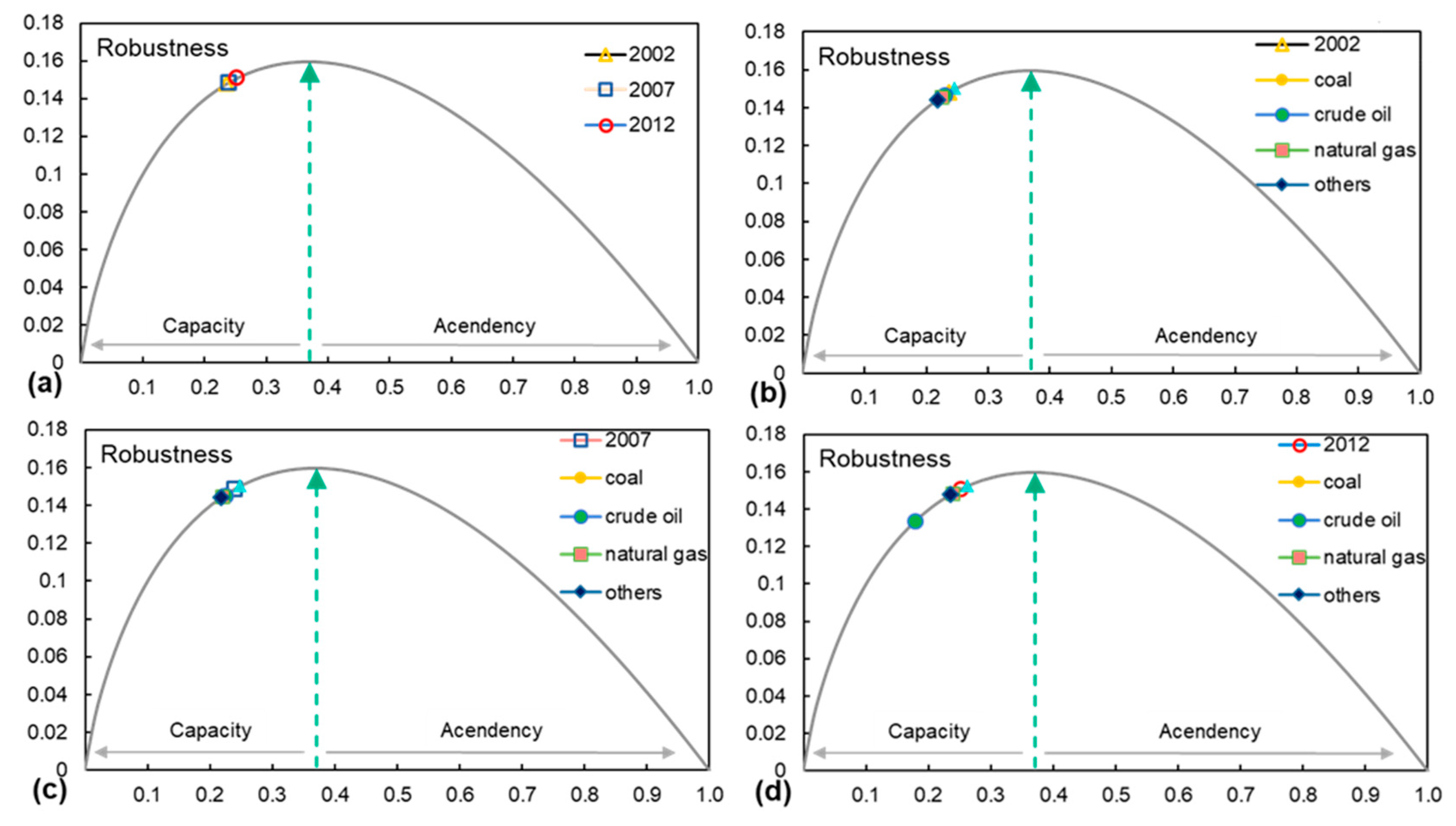
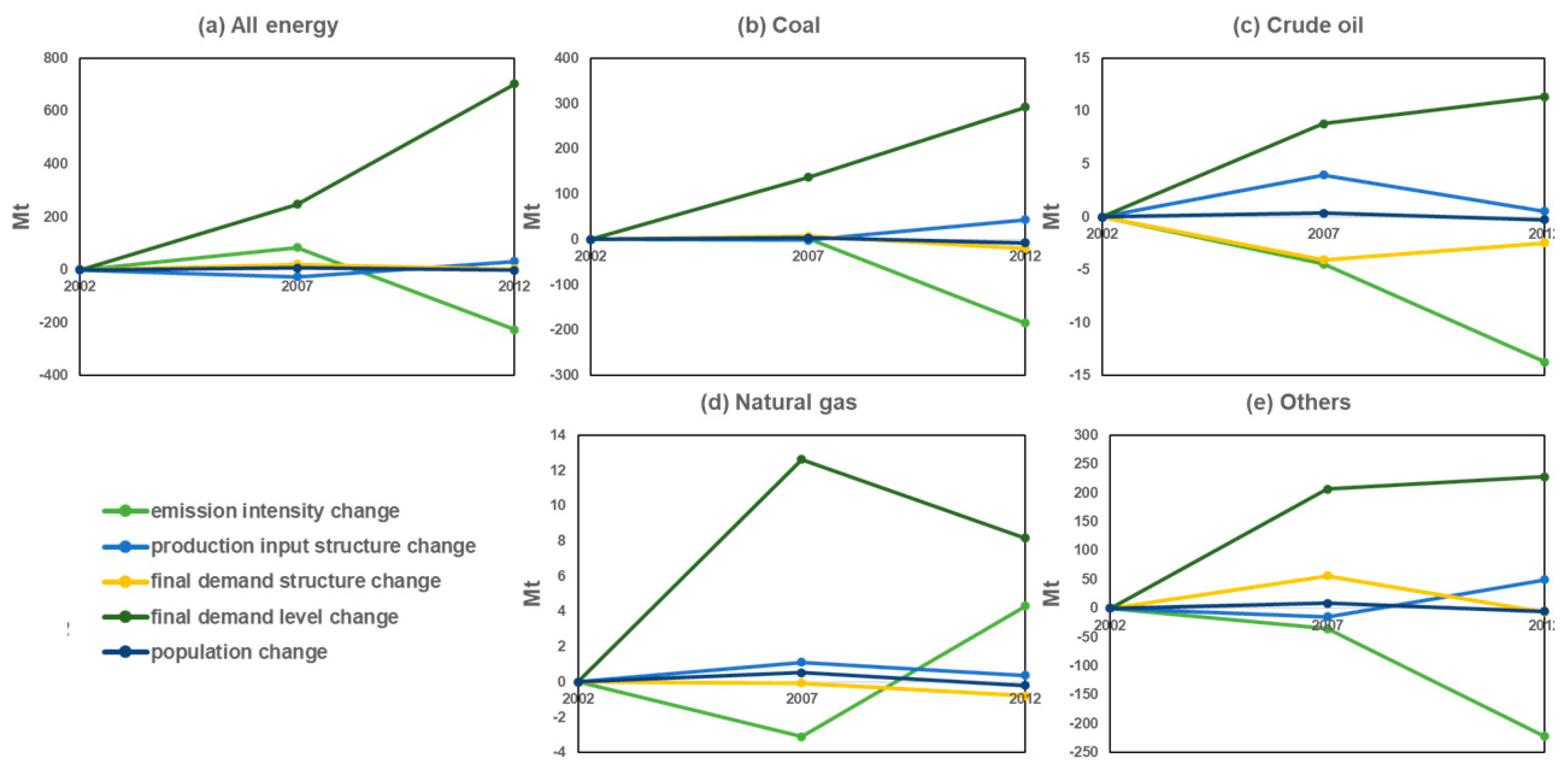
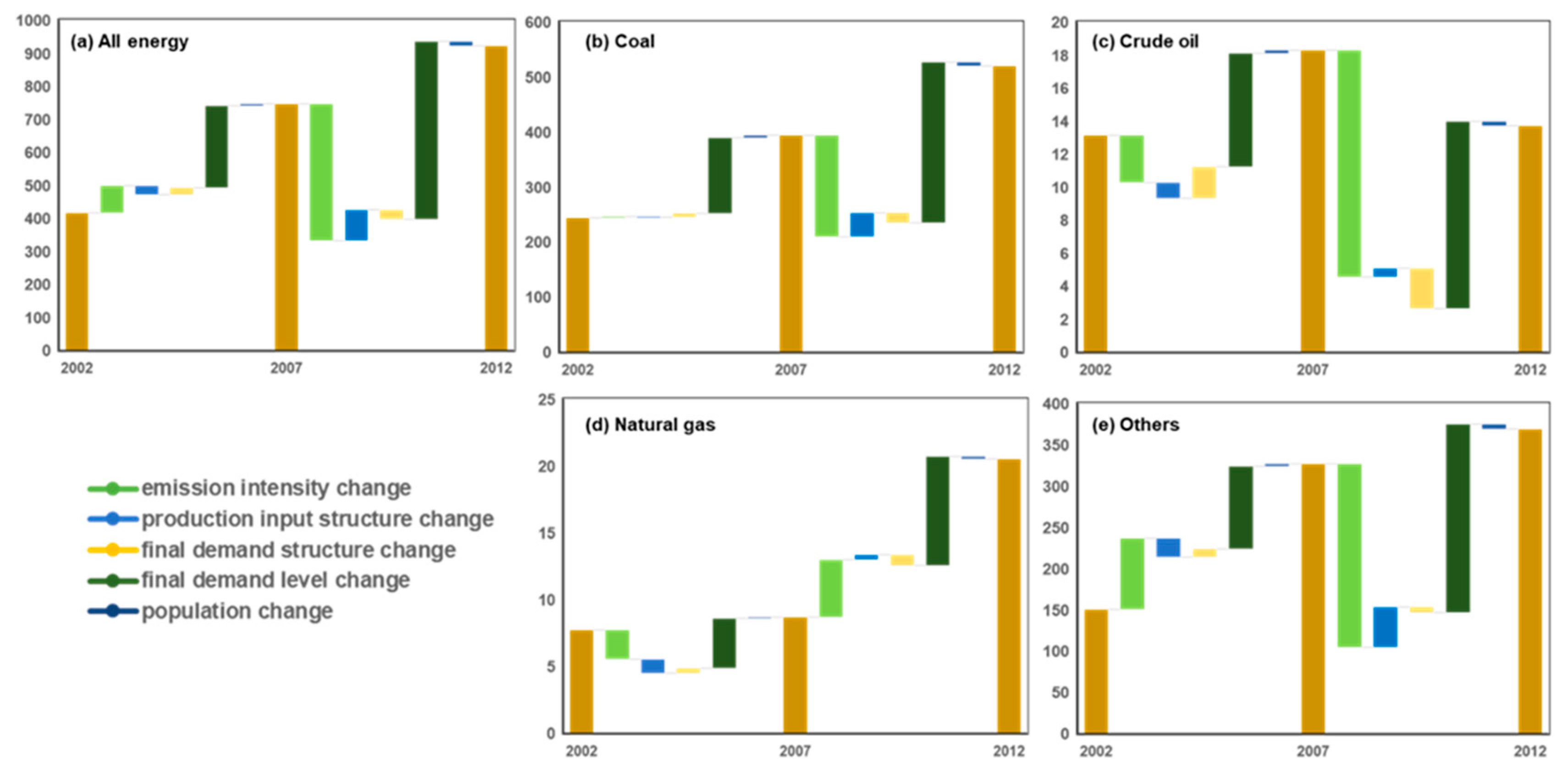
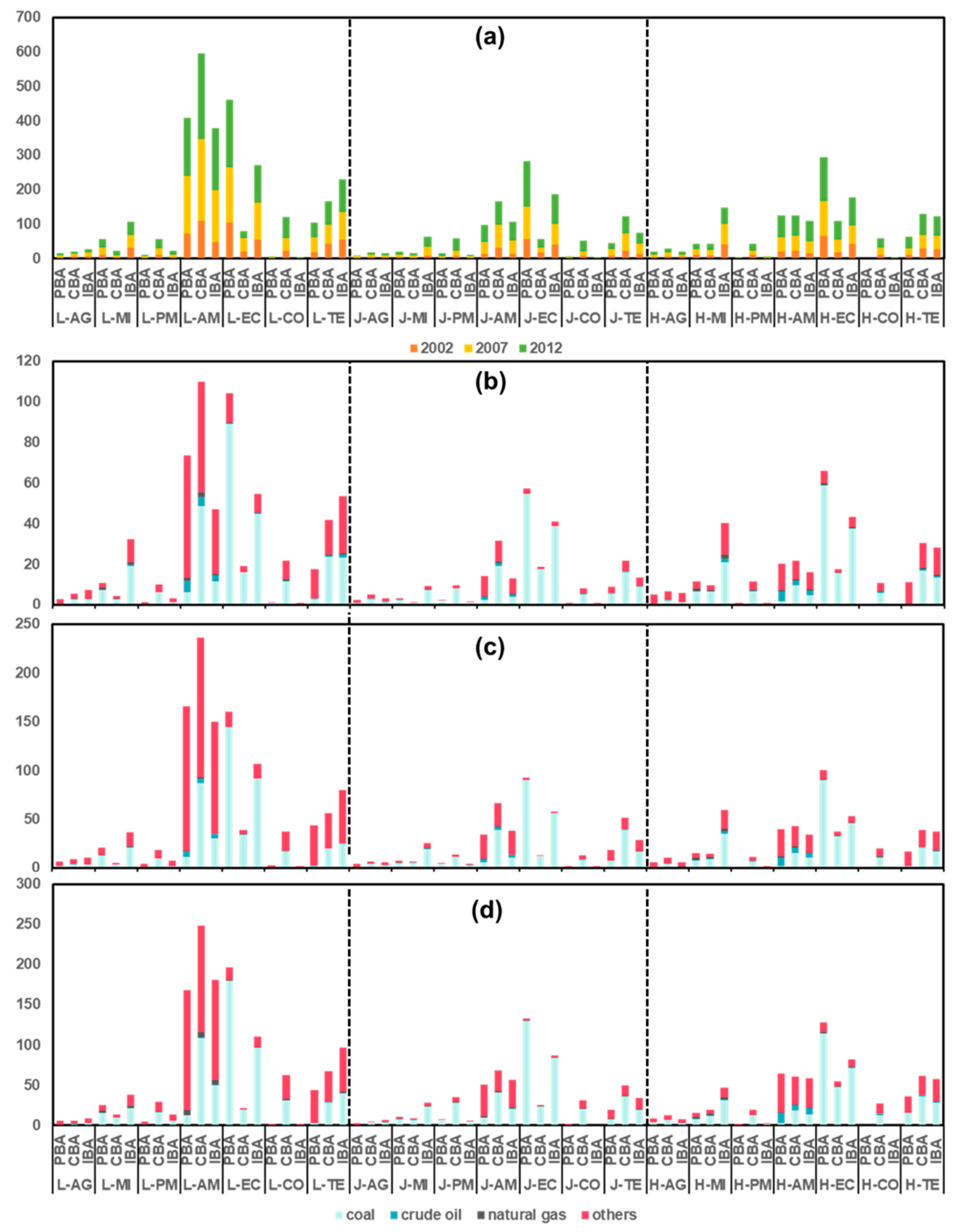

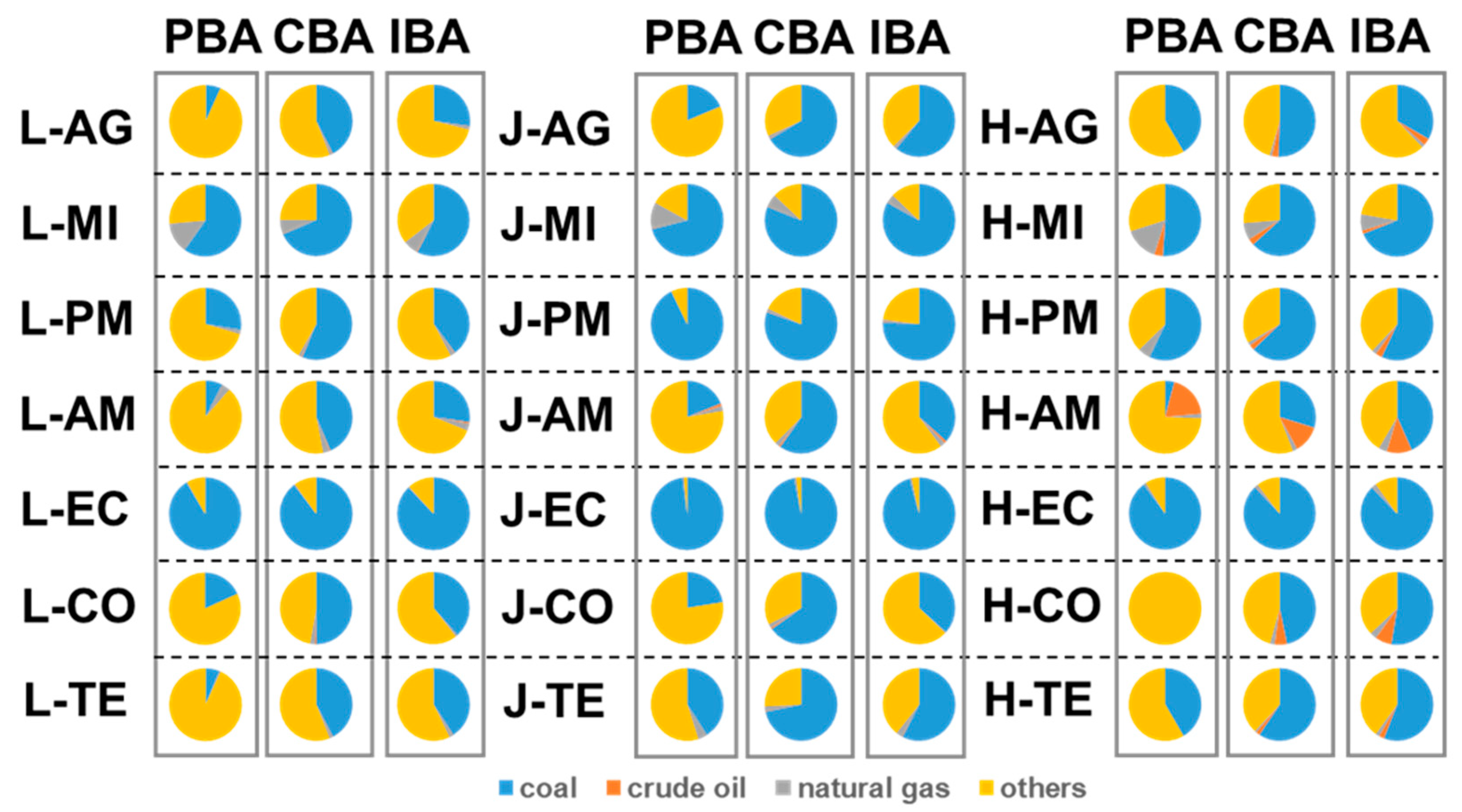
| Accounting Methods | Description |
|---|---|
| Production-based | Direct emissions from its local production activities |
| Consumption-based | Embodied emissions that are triggered by final demand |
| Income-based | Enabled emissions that are pulled by primary inputs |
© 2020 by the authors. Licensee MDPI, Basel, Switzerland. This article is an open access article distributed under the terms and conditions of the Creative Commons Attribution (CC BY) license (http://creativecommons.org/licenses/by/4.0/).
Share and Cite
Zang, H.; Zhang, L.; Xu, Y.; Li, W. Dynamic Input–Output Analysis of a Carbon Emission System at the Aggregated and Disaggregated Levels: A Case Study in the Northeast Industrial District. Sustainability 2020, 12, 2708. https://doi.org/10.3390/su12072708
Zang H, Zhang L, Xu Y, Li W. Dynamic Input–Output Analysis of a Carbon Emission System at the Aggregated and Disaggregated Levels: A Case Study in the Northeast Industrial District. Sustainability. 2020; 12(7):2708. https://doi.org/10.3390/su12072708
Chicago/Turabian StyleZang, Hongkuan, Lirong Zhang, Ye Xu, and Wei Li. 2020. "Dynamic Input–Output Analysis of a Carbon Emission System at the Aggregated and Disaggregated Levels: A Case Study in the Northeast Industrial District" Sustainability 12, no. 7: 2708. https://doi.org/10.3390/su12072708
APA StyleZang, H., Zhang, L., Xu, Y., & Li, W. (2020). Dynamic Input–Output Analysis of a Carbon Emission System at the Aggregated and Disaggregated Levels: A Case Study in the Northeast Industrial District. Sustainability, 12(7), 2708. https://doi.org/10.3390/su12072708




